All you need to know for visiting the Pantheon, Rome: the best time to go, how to get there, the best things to see, frequently asked questions.
The Pantheon is one of the most famous Rome monuments and one of the most beautiful.
An ancient Roman building dating from Imperial times, the Rome Pantheon was born as a temple devoted to all Roman Gods and Goddesses (Pan=all; Theon=God, in Greek) but in the VII century it turned into a Christian basilica and still nowadays operates as a church.
Located right in the heart of the city, it is at the center of a labyrinthine set of cobbled alleys and small streets and towers above one of Rome’s most beautiful squares, Piazza della Rotonda.
Visiting the Pantheon is easy and while you may find yourself going inside only once, its central location means you will stumble onto it several times during your walks around Rome city center.
This may sound repetitive, however, the Pantheon is all but!
I have been living in Rome most of my life and every time I pass by the Pantheon I stop and take it in: even just its facade is magical!
The light at different times of the day, its details, its timeless and unique beauty make it one of those sites you never tire of.
Piazza del Pantheon is simply one of the most beautiful squares in Rome and the Pantheon is one of the most beautiful churches in Rome, a real jewel in the crown.
These is my guide for visiting the Pantheon and my tips for escaping the crowds, intense at such a popular site.
Rome – the city of visible history, where the past of a whole hemisphere seems moving in funeral procession with strange ancestral images and trophies gathered from afar.” – George Eliot, novelist
Find more travel quotes about Rome here
Please note: this post contains affiliate links and, should you make a purchase through them, we might make a small commission.
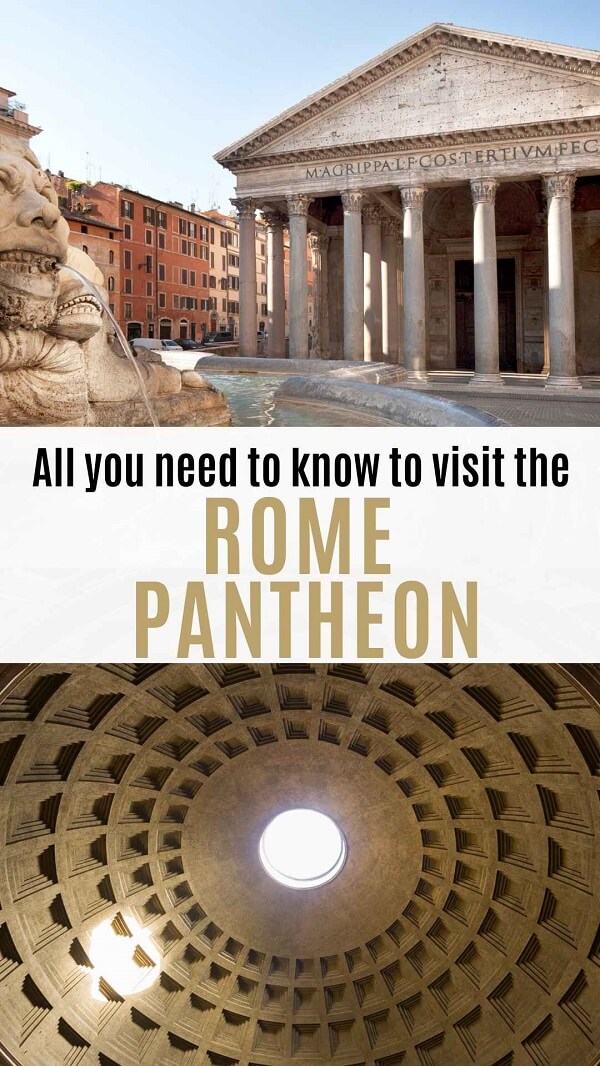
Visiting the Pantheon essential info to plan your visit
Address: Basilica del Pantheon, Piazza della Rotonda, Rome
Pantheon tickets Cost:
- Adult: 5 Euro
- Under 18: free (free tickets available on the website. Select the appropriate ticket for each visitor)
- EU citizens between 18-25 years of age with ID: 3 Euro
- Selected categories (AIRE Citizens, visitors with disability and more, find the official list here) Free
Opening hours: 9am to 7pm (Ticket office closes at 6pm; last admission it as 6.30pm)
Closed on: 1st January, 1st May and the 25th December
Dates of notice: The Pantheon is a functioning church and hosts religious celebrations and events on several days. These may impact your visit: you can check what is foreseen here and plan accordingly.
How to get tickets for visiting the Pantheon
A new entry fee to the Rome Pantheon is in place since July 2023, a significant change considering the Pantheon had been free until then!
You can get tickets to the Pantheon online (info below) or you can queue up on the day: the line tends to be long on the day and even it is moves fast, buying in advance is something I recommend.
How to book Pantheon Tickets from the official website
Booking tickets to the Rome Pantheon is not super straightforward, so I hope this guide can come in handy.
To book Pantheon tickets:
- Go onto the office site of Italy’s museums >>> Musei Italiani Portal

2. Click On ‘Tickets’ and you will land on a page with a calendar. Need to know: regardless of how many months may appear on this screen, tickets are only available for the current week.

3. Click on the current month and you’ll land on a calendar page with dates and times. Select the one suitable to you

4. Click on the ‘continue’ button at the end of the page (bottom right) and you’ll land on a page with all the ticket types. Select all that is relevant and click on the ‘buy’ button on the bottom right of the page.

5. Once you click ‘buy’ you’ll land on a page that will ask you to either login or continue as guest. I recommend you login as I found the system to be glitchy if you do not.
If not logging in, you will find yourself on a page with a summary of your tickets and a request to add names.
Click on the small arrow on the right of each ticket and the name fields will appear. Fill in the data required and click continue. A summary of your purchase will appear with a button to pay


If you decide to login, you will be directed to simple instruction to register first and your data will appear automatically. You will however still have to add those of the other participants, if buying for several people.
6. In either case, you then click on the ‘buy now/ complete purchase’ button on the right bottom corner of the page.
7. A new page with a login screen will appear. Enter your email as required, then on the next screen ‘accept’ the terms of use. You’ll finally get to a payment screen
8. NEED TO KNOW: there are several payment methods but for some reasons foreign card payments occasionally result in an error message. By trial and error it seems the best way to complete payment to be by choosing ‘other methods’ which include PayPal, Apple Pay etc.

9. Done! At this point your ticket should be issued as you are good to go!
How to buy Pantheon tickets at the door
If you are not in a position to book tickets, you can also buy Pantheon tickets at the door.
The lines tend to be long yet they move fast, so don’t despair until you try.
One important thing to know:
At the Pantheon there are currently 3 lines:
- One for ticket holders
- One to buy tickets by card
- One to buy tickets cash
The cash / card lines are not well indicated! It is paramount to spend some time picking the correct one should you only have one of the two methods of payments.
Please note: this system is new and, as you can see, far from straightforward. I will endeavour to keep this post as updated as possible but since it’s a brand new system, do take into accounts on the day things can be a little different on the spot than explained here.
Other tickets
Other ways to purchase ticks to the Pantheon are via third party ticket providers such as GetYourGuide.
The advantage is an easy to use interface and instant confirmation on your phone although the cost of the ticket is higher than going direct. The one I like purchased this way is this one:
Entry ticket with audioguide I like these because the Pantheon doesn’t have info panels inside so unless you study beforehand or you have an audioguide, you may not know what you are looking at.
Make sure you read carefully how the ticket works and where to collect the audioguide
What to wear for visiting the Pantheon
The Pantheon is a Catholic Church and, as such, requires modest attire to allow entry.
This rule is not exceptionally strict here; however, it is dictated by the religious nature of the space so, even if you can get away with revealing clothing, it is good to dress for it.
White this may seem daunting, especially if visit during the hot summer months, following a few basic rules will suffice:
>>> Avoid very short shorts and mini skirts. These are deemed too revealing for churches and may cause offence to those in prayer. Longer skirts (below the knee) or linen trousers are a more respectful option.
>>> Cover shoulders (and belly, cleavage etc). If wearing a strappy top, have a shawl / pashmina/ pareo with you to cover up when needed.
The rules doesn’t apply to small kids so don’t worry about what they are wearing, they will be fine! With teens, however, you may want to be mindful and have them follow the same rules as adults.
Good to know: sandals flip flops etc are not a problem, you can wear whatever shoe ware you want!
If you need help navigating the church dress code in Rome, you can use this Vatican dress code as guidance.
While this may sound daunting, especially if visiting Rome in summer, it is not hard to dress for Rome churches. You can find my full packing list for Rome in the summer months here
Where to eat near the Pantheon
The Pantheon is in an area full of delicious restaurants and you won’t have issues finding places to eat. Some places I like particularly are:
- Armando al Pantheon – a local legend for amatriciana https://maps.app.goo.gl/NdAt7YJ3mLgqBnNL7
- La Ciambella – delicious, Michelin rated restaurant for a special treat https://maps.app.goo.gl/xw4ru1afj332V1dJ7
- Pandali – casual, gluten free eatery https://maps.app.goo.gl/AhPP8So2SfwP5AY7A
- Emoteca Corsi – traditional local restaurant, casual, with ever changing menu https://maps.app.goo.gl/VfRTcgLmtTutvBLq6
How to include a visit to the Pantheon in your Rome itinerary
As I mentioned above, the Pantheon is right in Rome city center and very close to other attractions such as Piazza Navona, Trevi Fountain and the Spanish Steps, just to mention the best known.
You can find here >>> our guide to the Pantheon neighbourhood and its highlights
This means that you can easily include it in your itinerary, as long as you find yourself in the city center.
You can find our recommended Rome itineraries including the Pantheon at the bottom of this page.
This map gives you an overview of the main attractions in Rome, and their distance from each other.
The Pantheon is the blue pin – as you can see, it is close to most sites, the only exception being the Vatican, which is easier to reach by bus.
Top tip! Around the Pantheon there are many small, hidden, fascinating thing to see. Read here >> my selection of hidden gems near the Pantheon I recommend you seek out.
How to get to the Pantheon by public transport
The Pantheon is in a part of Rome mostly closed to traffic so the best way to get there is on foot.
You can easily walk to the Pantheon from Via del Corso / Piazza Venezia and also from Largo di Torre Argentina.
The walk from Via del Corso is slightly longer. However, it is also more scenic as it allows to reach the Pantheon from the front and see its facade first!
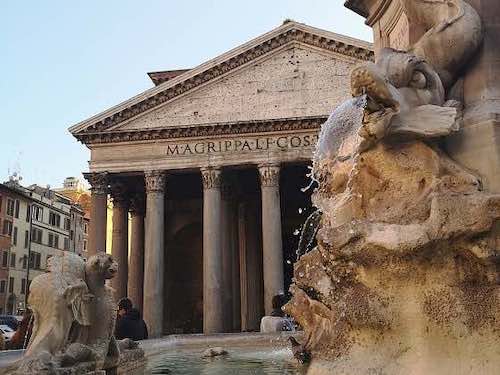
Getting to the Pantheon by bus
If you are not staying nearby, several public transport options bring you to this area, some of the most convenient being buses 30, 40, 62, 64, 81, 87 and 492.
The closest stops are on Via del Corso, Piazza Venezia, Largo di Torre Argentina, all only a few minutes walk from the Pantheon.
Getting to the Pantheon by hop on, hop off bus
Hop on-hop off buses cannot reach the Pantheon as the area is closed to traffic and with lanes too narrow for buses to fit.
The closest stop is on Via del Corso / Piazza Venezia / Largo di Torre Argentina, depending on the line you are on.
Getting to the Pantheon by taxi
Taxis can bring you very close to the Pantheon but will most likely drop you at the back of it on Piazza della Minerva, just at the back of the building, less than minute from the entrance.
How long you need for visiting the Pantheon
How long you need for visiting the Pantheon depends on your interest and, even more, the length of the line outside!
The Pantheon itself is only one chamber so once you are in, the visit is not long and can take as much or as little time as you are ready to spare.
In general, take into consideration that:
- If you only want to see the facade, a few minutes are enough.
- If you want to go in and see the Oculos only (the main things most visitors come here for), Raphael’s tomb and the tomb of Queen Margherita, you will need about 5 minutes.
- The Pantheon Tour with audio guide takes 45 minutes.
This means it is easy to include the Pantheon in a itinerary of central Rome and still have time for additional activities.
The best time for visiting the Pantheon
The best time to visit the Pantheon without crowds is the early morning. At this time, most tourists are still asleep and you can get see the Pantheon with ease. It is never empty but in the early morning it is as empty as it gets!
That said, the best time to see the Pantheon is anytime without a major line!
When I was growing up in Rome, tourism was strong in Rome but I was always able to walk inside the Pantheon at leisure, the lines being non-existent.
Lately, I have found myself unable to get in at all due to lines so long, they meander all the way across the Piazza!
This is not surprising as the Pantheon is one of the top ten attractions in Rome and everyone wants to see it (And rightly so)!
If you find yourself at the Pantheon on a crowded day, my recommendation is: see the outside and come back later.
The lines usually are worst from late morning to mid-afternoon but are minimal in the early morning and subside as the sun starts to go down.
If you find the Pantheon line free, make the most of the moment and get in straight away!
Good to know: the Pantheon facade gets all lit up at night and looks wonderful. The lights bring to life not just its columns but the recesses of the imposing ceiling of its. For a view of its outside, the evening is the best time for visiting the Pantheon in my book!
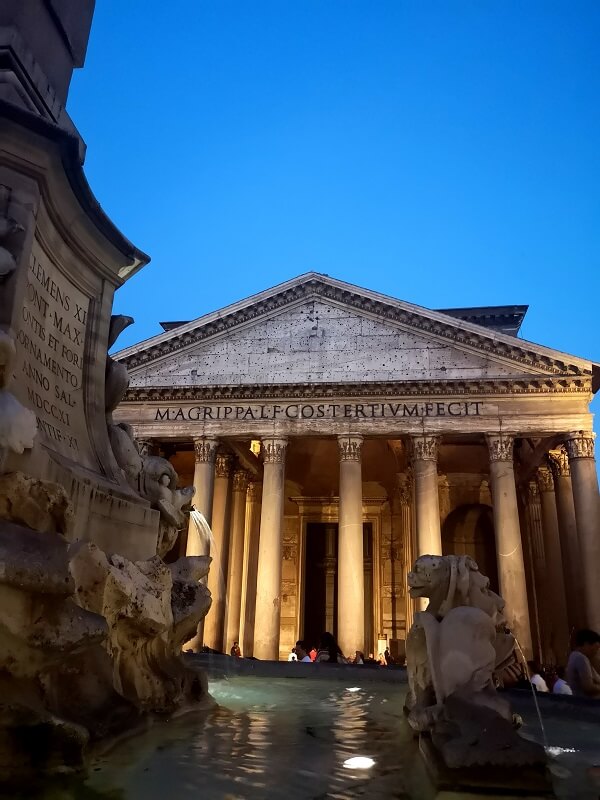
What is special about the Pantheon
The Pantheon is an ancient Roman building originally dating back to August times (I century AD).
It is unique under many accounts, which include its shape, proportions, sate of conservation and history.
The main reasons that make the Rome Pantheon special are:
It is unbelievably well preserved
The Pantheon is one of the best-preserved ancient monument in Rome.
The Pantheon was first built by Consul Agrippa in the I century AD, as part of a big urban regeneration project championed by Emperor Augustus.
Augustus wanted the whole area to have a strong symbolic meaning and built his own Mausoleum in such a way that his tomb and the Pantheon would directly face each other, across the Campus Martius, the area associated with Romulus’ ascension to the sky.
When Hadrian rebuilt the Pantheon, he followed this tradition and even left the name of Agrippa on the main facade, as that of the Pantheon’s builder.
He only added a mention of the reconstruction after Agrippa’s name, ensuring continuity.
In later times, it is believed the Pantheon was most likely preserved thanks to its use as a church, which saved him from the theft hand destruction other buildings faced.
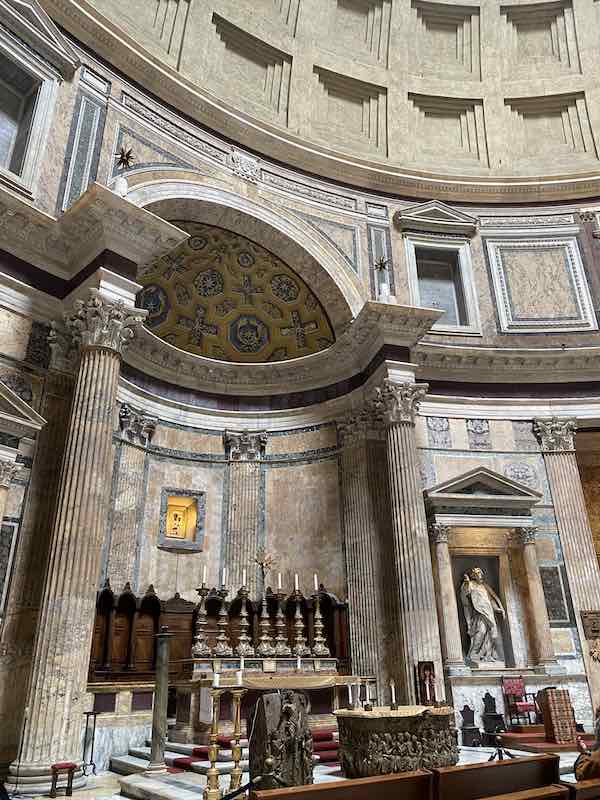
It has a record-breaking dome
The Pantheon is surmounted by an impressive dome that holds the record for being the biggest unsupported dome in the world.
The dome has a diameter of 43.30m (142ft), which is also the exact distance between the Pantheon floor and the top of the dome.
This means that if you were to draw a circle inside the Pantheon following the outline of the dome, you would get a perfect sphere.
You can see what this means and what an engineering achievement this detail means here (the diagram is on the right on desktop, at the bottom on mobile).
It has a hole in the roof – by design
Probably the most distinctive trait of the Pantheon is the hole in its roof, the so-called ‘oculos’. The hole is there by design and is the only source of light inside the pantheon.
Despite what gossips sometimes say, the hole means that rain does get inside the Pantheon!
On a rainy day, the whole floor below the oculos becomes wet and slipper (it usually gets cordoned off to avoid accidents) and the water gets drained and carried away but a clever drainage system built by the Romans.
Top Tip! To fully appreciate the shape of the Pantheon dome, I recommend you see it from inside and then see it from above. Some excellent rooftop bars in Rome City center offer amazing views of it – one I love is the Divinity Terrace, from where you see the Pantheon Dome exceptionally well.
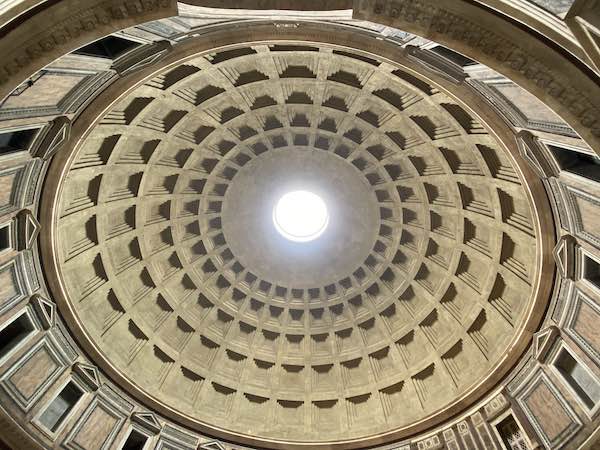
It is built to match recurring astronomical events
On the 21st of April, the day of Rome’s birthday (dies natalis) the light enters the Pantheon at a peculiar angle, flooding its entrance with blinding power.
This only happens one day each year and the Soprinendenza Archeologica (the body supervising archaeological excavation in Rome) has determined it was by order of Emperor Augustus, under whom the first building of the temple took place.
Other light effects happen during the Solstices and Equinoxes, a peculiarity that has made many wonder if the Pantheon may have been built as a giant sundial.
You can read more about this fascinating hypothesis and exact light patterns here
The best things to see at the Rome Pantheon
The main elements that make the Pantheon special are also the most important things to see in the Pantheon.
I recommend in particular you seek out and pay attention to:
The immense columns at the Pantheon entrance
The Pantheon Columns are remarkably thick.
This is because, unlike others in Rome, they are not decorative but they actually support the structure.
Pay attention to their thickness and compare it with that of the many other columns in Rome.
The only ones somewhat similar to it are those of Trajan’s basilica, now kept in Palazzo Valentini.
Need to know: Ancient Rome lied at a lower level than modern Rome. Because of this, the Pantheon looks smaller than it would have looked to ancient Romans. In 2020, archaeologists found large steps under the current street levels, proving that the Panthen was an imposing building, towering above its visitors. The excavation has since been closed up again.
The stunning ceiling of the temples’ pronaos – the entrance to the temple
If you can, come here and look up during the day and again after dark, when you can admire the new lighting system: it makes the ceiling incredibly scenic!
This is one of my favorite places to visit in Rome at night.
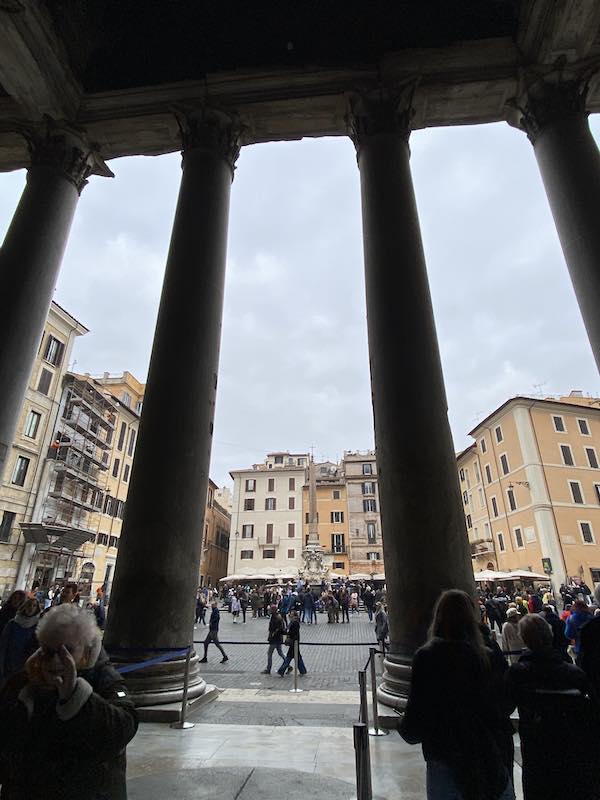
The peculiar, round shape of the structure
The peculiar shape of the Pantheon can only partially be seen by visitors.
The incredible proportions of the place and its geometry only comes to light if you see a section drawing of it however, the circular shape of the Pantheon floor is well visible and makes it one of the most unique churches in Rome.
The oculus – the hole on the Pantheon ceiling
The Oculus is what brings most people to the Pantheon and it is indeed interesting to see. Look up beauty and admire the sky from whiting the church, then imagine rain coming in or rose petals, scattered into the Pantheon from above each year to celebrate the Pentecost’s.
The drainage system for rainwater
Despite what many people believe, it rains in the Pantheon! To drain rain waters, the ancient Roman engineers created a drainage system that we can still see today.
On a rainy day, the wettest part of the Pantheon is cordoned off but be careful as it is slippery!
The tombs of Raffaello Sanzio (Raphael)
Raphael is buried in the Pantheon.
His grave is worth seeing.
It is surmounted by a sculpture by Raphael’s disciple Lorenzetto and has an inscription with verses that reads: ‘Qui giace Raffaello, dal quale la natura temette mentre era vivo di esser vinta; ma ora che è morto teme di morire’ (here lies Raphael, from whom nature, while alive, worried to be outdone and now, him dead, fears to die)
The tombs of Italy’s Royal family
Rome Pantheon is the resting place of several members of Italy’s royal family including Vittorio Emanuele II First King of Italy (to whom the Vittoriano monument is dedicated), King Umberto I and Queen Margherita of Savoy.

Visiting the Pantheon with kids: tips and need to know
The Pantheon is one of the most inspiring cultural sites to see in Rome with kids.
Children tend to love the peculiar shape of the building and the presence of the hole in the roof, the water draining system and the grave of Queen Margherita (of pizza fame!) makes it usually a hit.
Also, if you can get in without a long line, it is a site that doesn’t require a lot of time so it is suitable even fort kids’ attentions spans.
Here are my tips on what kids may like.
Get them to notice the columns
The Pantheon columns are remarkably thick so thick actually, you need several people to hug them!
My kids were all over this fact and enjoyed it immensely, as they tried to see how many of them would be needed to embrace one of these giants.
Please be careful with the columns: they are invaluable so while you get your children close to them, make sure they do not involuntarily damage them – they can circle around them without making contact.
You do not actually need to touch the columns to appreciate how big they are: they are genuinely immense!
Ask them if they reckon it rains inside the Pantheon
And point them towards the holes in the ground that carry away the water!
Tell them the story of the Queen who gave the name to Pizza Margherita
Queen Margherita di Savoia is buried in the Pantheon and while her tomb itself is of no interest for children, her contribution to Italian cuisine may well be!
History tells us that the original Pizza Margherita took its names from this queen for whom it was first cooked.
The color red, white and green of the tomato sauce, mozzarella and basil are the same as the Italian flag – a patriotic pizza for the queen of Italy!
Top tip! If you can’t get them to stop thinking about pizza after this visit, you can pick a place to eat from our list of best pizza places in Rome. Some are in the city center and not far from the Pantheon!
Get gelato afterward
The Pantheon is not very interesting for kids and you may find yourself in need of a bribe, I mean a pick me up after the visit.
Luckily, the pantheon is in an area with many cafes and even better, gelato places!
My favorite is Gunther on Piazza Sant’Eustachio nearby.
Best Rome hotels near the Rome Pantheon
You can find my full selection of the best hotels in the Pantheon area here
Visiting the Pantheon in Rome – pin this!

Not sure how to include this attraction in your Rome itinerary? Check our Rome itinerary suggestions below
Rome in a day: detailed Rome city centre itinerary for first time visitors
Rome in two days A detailed itinerary for two full days in Rome
Rome in three daysRome in four days – day-by-day 3 day Rome itinerary
Rome in five days – complete Rome itinerary with main attractions and less usual sites for visitors with more time in the city
Traveling to Rome with kids? Find our family guide to Rome here.
I hope you enjoyed this guide and found my tips for visiting the Pantheon useful. Safe Rome travels!
This article was originally published in 2020 and has now been fully updated with recent photos and access rules.
